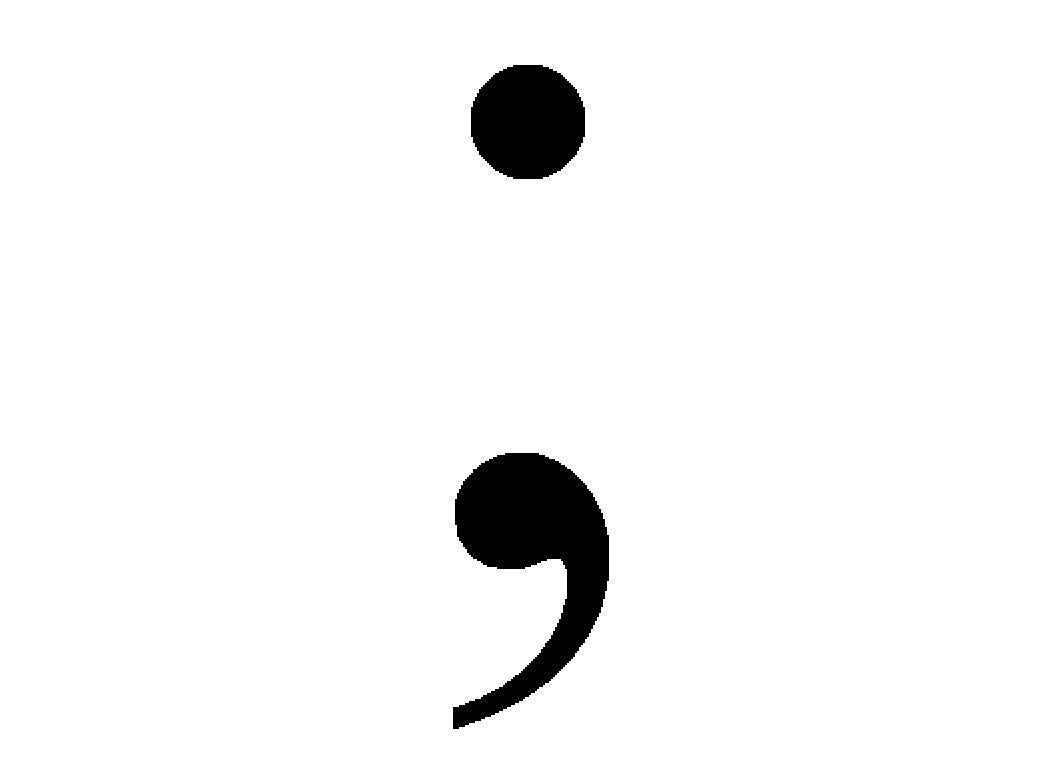 Welcome to the first post in my new "Punctuation 101" series! I've decided to kick off the series with what used to be my least favorite punctuation mark. However, after taking a surprisingly fun grammar class, I have learned to appreciate the semicolon.
Welcome to the first post in my new "Punctuation 101" series! I've decided to kick off the series with what used to be my least favorite punctuation mark. However, after taking a surprisingly fun grammar class, I have learned to appreciate the semicolon.As you all know, I read A LOT. And in my reading, I've found that a lot of writers avoid using the semicolon, or they use a comma when they should actually be using a semicolon. I think part of the problem may be that a lot of people do not really understand what the purpose of the semicolon is or how to properly use it in their writing.
If you are one of these befuddled folks who are mystified by the semicolon, have no fear! This post will explain all you need to know about the semicolon.
The semicolon is a very handy punctuation mark. It can separate clauses, emphasize relatedness, clarify lists, and add variety to your writing.
So when exactly should you use a semicolon? There are three possible uses.
1) In a sentence with two independent clauses not linked by a connecting word.
Basically, if both parts of your sentence could stand alone as their own sentences, then they are independent clauses, and you can link them without using a word like "and" or "but" or "so" by using just a semicolon. These sentences should also be closely related or of equal emphasis; the semicolon helps to visually show that these sentences are closely connected.
Correct: The weather was terrible that morning; the sky was hidden behind dark clouds and thunder rumbled in the distance.
This sentence is correct because the semicolon is linking two related independent clauses and there is no connecting word.
Incorrect: The dog drooled in anticipation as he watched the burger flip in the air; the Robertson's had purchased a new car.
While this sentence does have two independent clauses and no connecting word, a semicolon should not be used in this case because the two clauses are unrelated.
Incorrect: The gown was exquisite; and she looked incredible wearing it.
This sentence is incorrect because there is a connecting word. To fix this sentence, you could remove the "and" or use a comma instead of a semicolon.
2) In a sentence with two independent clauses and a conjunctive adverb or a transition.
What are conjunctive adverbs you ask? It's just a fancy name for adverbs that link independent clauses. However, therefore, moreover, nevertheless, otherwise, consequently, etc. are all conjunctive adverbs. Transition words include for example, in addition, on the other hand, in fact, etc.
Correct: Julia had a traumatic experience involving the circus when she was a little girl; in fact, that childhood trauma has left her with a permanent fear of clowns.
This sentence is correct because both halves of the sentence could be their own sentences (independent clauses), the clauses are related, and there is a transition.
Incorrect: The pasta is disgusting but the chicken; however, is excellent.
This sentence is incorrect because the part of the sentence after the semicolon is not an independent clause. In this case, "however" is working as a transitional word, not a conjunctive adverb, and the semicolon should be a comma.
3) To help clarify and organize a list or series when individual items in the list/series already use commas.
Correct: Squeezed into the small tent with me are Sarah and Beth, my best friends; Julie, Sarah's cousin; and Mr. Woofus, who wouldn't stop whining until we let him in.
Correct: San Francisco, California; New York City, New York; and Miami, Florida are all famous cities in the United States.
The two sentences above are correct because they are both lists that already use commas. The semicolons help to organize and separate the the list items.
Incorrect: The lunch menu includes a side salad; sandwich; drink; and cookie.
This sentence uses semicolons incorrectly because there are no commas already being used. This list only needs commas, not semicolons.
If the list gave different options for the menu, then you could use semicolons. For example, the lunch menu includes a side salad; your choice of chicken, ham, or vegetarian sandwich; a water, juice, or soda; and a cookie or brownie.
So there you have it! All the information you need to know about the handy dandy semicolon and how to use (and not use) it in your writing. Go forth and enjoy adding the semicolon to your punctuation toolbox.
No comments:
Post a Comment